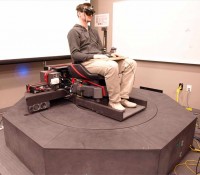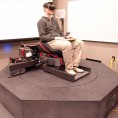Spatial Updating With(out) Physical Motions?
How important are physical motions for effective spatial orientation in VR?
Most virtual reality simulators have a serious flaw: Users tend to get easily lost and disoriented as they navigate. According to the prevailing opinion, this is because physical motion cues are absolutely required for staying oriented while moving. In this study, we investigated how physical motion cues contribute to spatial updating in a realistic and highly structured virtual environment, using a rapid point-to-origin paradigm without performance feedback.
After visually displayed passive movements along curved streets, participants were asked to point back to where they started. In some conditions they physically rotated with the curve, in others they only received visual motion cues. Results showed that physical motion cues did not affect pointing error or response time significantly. This suggests the possibility that physical motion cues might be unnecessary if visuals are realistic enough. Furthermore, two participants unexpectedly exhibited ‘non-turning’ pointing behavior, reacting as if they had not updated their headings during movements across all conditions. Implications and follow-up studies are discussed.
Below is a video of Salvar Sigurdarson’s first ever conference talk at the IEEE Virtual Reality conference entitled “Can physical motions prevent disorientation in naturalistic VR?”.

And here’s a more recent presentation from Bernhard on online spatial orientation study and the rather unexpected response patterns that we observed — and how we might be able to make sense of them.

Here’s the reference for the talk: Riecke, B. E., Stepanova, E. R., & Kitson, A. 2016. New response patterns in point-to-origin tasks depending on stimulus type and response mode. Talk presented at the International Meeting of the Psychonomic Society, Granada, Spain.
Which direction is the origin of motion for this visually simulated locomotion in Virtual Reality? The below video shows a visually simulated locomotion of a 2-segment path in a simple virtual environment without any landmarks (i.e., just providing “optic flow”). Your pointing response can reveals whether you are a “Turner” or “NonTurner”, i.e., whether you tend to incorporate the rotation into your pointing response (and thus mental spatial representation) or not.

Related Publications
http://ispace.iat.sfu.ca/wp-content/plugins/zotpress/
37904
Nguyen-Vo, Thinh, and Bernhard E. Riecke. 2017. “Detecting Spatial Orientation Demand during Virtual Navigation Using EEG Brain Sensing.” Poster presented at the Psychonomic Society 58
th Annual Meeting, Vancouver, BC, Canada, November.
(Download)
37904
Riecke, Bernhard E., Ekaterina R. Stepanova, and Alexandra Kitson. 2016. “New Response Patterns in Point-to-Origin Tasks Depending on Stimulus Type and Response Mode.” Talk presented at the International Meeting of the Psychonomic Society, Granada, Spain, May.
https://youtu.be/miiPjAUb77Y.
37904
Kitson, Alexandra, Daniel Sproll, and Bernhard E. Riecke. 2016. “Influence of Ethnicity, Gender and Answering Mode on a Virtual Point– to-Origin Task.”
Frontiers in Behavioral Neuroscience 11 (22): 1–18. https://doi.org/10.3389/fnbeh.2016.00022.
(Download)
37904
Kitson, Alexandra, Daniel Sproll, and Bernhard E Riecke. 2014. “Does Movement Experience Influence Navigation Strategy in a Virtual Point-to-Origin Task?” Poster presented at the 55
th Annual Meeting of the Psychonomic Society (Psychonomics), Los Angeles, USA.
(Download)
37904
Sproll, Daniel. 2013. “Influence of Ethnicity, Gender and Answering Mode on Reference Frame Selection for Virtual Point-to-Origin Tasks.” BSc Thesis, Universität Osnabrück & Simon Fraser University.
(Download)
37904
Riecke, B. E, and Salvar Sigurdarson. 2013. “Simple Modifications of Visuals Can Enhance Spatial Orientation Ability in Virtual Environments, Whereas Adding Physical Rotations May Not.” Talk presented at the 54th Annual Meeting of the Psychonomic Society (Psychonomics), Toronto, Canada.
37904
Gramann, Klaus, Shawn Wing, Tzyy-Ping Jung, Erik Viirre, and Bernhard E. Riecke. 2012. “Switching Spatial Reference Frames for Yaw and Pitch Navigation.”
Spatial Cognition and Computation 12 (2–3): 159–94. https://doi.org/10.1080/13875868.2011.645176.
(Download)
37904
Riecke, Bernhard E. 2012. “Are Left-Right Hemisphere Errors in Point-to-Origin Tasks in VR Caused by Failure to Incorporate Heading Changes?”
Lecture Notes in Computer Science 7463: 143–62. https://doi.org/10.1007/978–3-642–32732-2_9.
(Download)
37904
Riecke, Bernhard E., Salvar Sigurdarson, and Andrew P. Milne. 2012. “Moving Through Virtual Reality Without Moving?”
Cognitive Processing 13 (1): 293–97. https://doi.org/10.1007/s10339-012‑0491-7.
(Download)
37904
Gramann, Klaus, B. E. Riecke, Shawn Wing, Tzyy-Ping Jung, and Erik Viirre. 2010. “Brain Dynamics Associated with Navigation in 3-D Space.” Talk presented at the Neuroscience 40th Annual Meeting, San Diego, CA, USA.
37904
Riecke, Bernhard E. 2008. “Consistent Left-Right Reversals for Visual Path Integration in Virtual Reality: More than a Failure to Update One’s Heading?”
Presence: Teleoperators and Virtual Environments 17 (2): 143–75. https://doi.org/10.1162/pres.17.2.143.
(Download)




